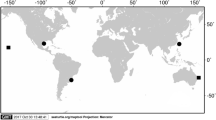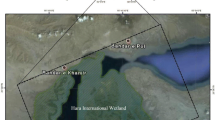Abstract
The objective of the present study was to investigate the levels of heavy metals, namely, chromium, copper, cobalt, nickel, and iron, in Western Reef heron (Egretta gularis) (n = 15) and Siberian gull (Larus heuglini) (n = 15) to (1) compare metal concentrations between two bird species with different trophic level, molting pattern, and life strategy; (2) examine species- and sex-related variations in trace-metal accumulation; and (3) determine the significance between heavy-metal concentrations in kidney, liver, and pectoral muscle. Bird samples were collected from November to December 2010 throughout the Hara Biosphere Reserve, and heavy metals were assayed by using a Shimadzu AA 680 flame atomic absorption spectrophotometer; the results were given as μg/g dry weight. Metal concentrations were different between the bird species as well as among bird tissues, but there was no difference (except chromium and iron in kidney) between sex (male vs. female). Mean levels in kidney of Western Reef heron and Siberian gull were chromium (0.96, 2.32 μg/g), copper (6.31, 10.55 μg/g), cobalt (0.12, 0.14 μg/g), nickel (1.13, 1.32 μg/g), and iron (37.92, 39.64 μg/g), respectively, whereas in liver they were chromium (1.05, 2.75 μg/g), copper (8.93, 12.63 μg/g), cobalt (0.09, 0.17 μg/g), nickel (1.1, 2.27 μg/g), and iron (34.03, 44.21 μg/g), respectively. Results showed that heavy-metal concentrations in Western Reef heron were decreased in the sequence iron > copper > nickel > chromium > cobalt, whereas in Siberian gull they were decreased in the sequence iron > copper > chromium > nickel > cobalt. Results also showed that in both species, the highest chromium and nickel concentrations were measured in female birds and the lowest in male birds, whereas the highest copper, cobalt, and iron (except iron in liver) concentrations were measured in male birds and the lowest in female birds.

Similar content being viewed by others
References
Barbieri E, Garcia CAB, Passos EDA, Aragão KAS, Alves JDPH (2007) Heavy metal concentration in tissues of Puffinus gravis sampled on the Brazilian coast. Revis Brasil Ornitol 15:69–72
Barbieri E, Andrade Passos ED, Filippini A, Souza dos Santos I, Borges Garcia CA (2010) Assessment of trace metal concentration in feathers of seabird (Larus dominicanus) sampled in the Florianópolis, SC, Brazilian coast. Environ Monit Assess 169(1–4):631–8
Battaglia A, Ghidini S, Campanini G, Spaggiari R (2005) Heavy metal contamination in little owl (Athene noctua) and common buzzard (Buteo buteo) from northern Italy. Ecotoxicol Environ Safe 60:61–66
Blomqvist S, Frank A, Peterson LR (1987) Metals in liver and kidney tissues of autumn-migrating dunlin Calidris alpina and curlew sandpiper Calidris ferruginea staging at the Baltic Sea. Mar Ecol Prog Ser 35:1–13
Boncompagni E, Muhammad A, Jabeen R, Orvini E, Gandini C, Sanpera C et al (2003) Egrets as monitors of trace metal contamination in wetland of Pakistan. Arch Environ Contam Toxicol 45:399–406
Breteler RJ (1984) Chemical pollution of the Hudson-Raritan Estuary. NOAA Tech Memo NOS/OMA 7
Bryan GW, Langston WJ (1992) Bioavailability, accumulation and effects of heavy metals in sediments with special reference to United Kingdom estuaries: a review. Environ Pollut 76:89–131
Burger J (1993) Metals in avian feathers: bioindicators of environmental pollution. Rev Environ Toxicol 5:203–311
Burger J (2002) Food chain differences affect heavy metals in bird eggs in Barnegat Bay, New Jersey. Environ Res 90:33–39
Burger J (2007) A framework and methods for incorporating gender-related issues in wildlife risk assessment: gender-related differences in metal levels and other contaminants as a case study. Environ Res 104:153–162
Canli M, Ay Ö, Kalay M (1998) Levels of heavy metals (Cd, Pb, Cu, Cr and Ni) in tissue of Cyprinus carpio, Barbus capito and Chondrostoma regium from the Seyhan River. Tur J Zool 22:149–157
Custer CM, Custer TW, Michael JA, Alan DA, David EW (2003) Trace elements in Lesser Scaup (Aythya affinis) from the Mississippi flyway. Ecotoxicol 12:47–54
Dauwe T, Bervoets L, Pinxten R, Blust R, Eens A (2003) Variation of heavy metals within and among feathers of birds of prey: effects of molt and external contamination. Environ Pollut 124:429–436
Deng H, Zhang Z, Chang C, Wang Y (2007) Trace metal concentration in Great Tit (Parus major) and Greenfinch (Carduelis sinica) at the western mountains of Beijing, China. Environ Pollut 148:620–626
Ebrahimpour M, Mushrifah I (2010) Seasonal variation of cadmium, copper, and lead concentrations in fish from a freshwater lake. Biol Trace Elem Res 138:190–201
Eisler R (2000a) Lead. In: Handbook of chemical risk assessment, health hazards to humans, plants and animals, vol 1, Metals. Lewis Publishers, Boca Raton, FL, pp 45–82
Eisler R (2000b) Cadmium. In: Handbook of chemical risk assessment, health hazards to humans, plants and animals, vol 1, Metals. Lewis Publishers, Boca Raton, FL, pp 1–34
Ek KH, Morrison GM, Lindberg P, Rauch S (2004) Comparative tissue distribution of metals in birds in Sweden using ICP-MS and laser ablation ICP-MS. Arch Environ Contam Toxicol 47:259–269
Gangaiya P, Tabudravu J, South R, Sotheeswaran S (2001) Heavy metal contamination of the Lami coastal environment, Fiji. S Pac J Nat Sci 19:24–29
Gochfeld M (1997) Factors influencing susceptibility to metals. Environ Health Perspect 105:817–822
Gochfeld M, Burger J (1987) Heavy metal concentrations in the liver of three duck species: influence of species and sex. Environ Pollut 45:1–15
Hindell MA, Brothers N, Gales R (1999) Mercury and cadmium concentrations in the tissues of three species of southern albatrosses. Polar Biol 22:102–108
Hui CA (1998) Metal and trace element burdens in two shorebird species at two sympatric wintering sites in southern California. Environ Monit Assess 50:233–247
Hutton M (1981) Accumulation of heavy metals and selenium in three seabird species from the United Kingdom. Environ Pollut 26:129–145
Ip CM, Li XD, Zhang G, Wong CSC, Zhang WL (2005) Heavy metal and Pb isotopic compositions of aquatic organisms in the Pearl River Estuary, South China. Environ Pollut 138:494–504
Johansen P, Mulvad G, Pedersen HS, Hansen JC, Riget F (2006) Accumulation of cadmium in livers and kidneys in Greenlanders. Sci Total Environ 372:58–63
Kim J, Koo T-H (2007) Heavy metal concentrations in diet and livers of black-crowned night heron Nycticorax nycticorax and grey heron Ardea cinerea chicks from Pyeongtaek, Korea. Ecotoxicology 16:411–416
Kim J, Koo TH (2008) Heavy metal distribution in chicks of two heron species from Korea. Arch Environ Contam Toxicol 54:740–747
Kim EY, Goto R, Tanabe S, Tanaka H, Tatsukawa R (1998) Distribution of 14 elements in tissues and organs of oceanic seabirds. Arch Environ Contam Toxicol 35:638–645
Kim J, Shin J-R, Koo T-H (2009a) Heavy metal distribution in some wild birds from Korea. Arch Environ Contam Toxicol 56:317–324
Kim J, Lee H-S, Koo T-H (2009b) Heavy metal concentrations in three shorebird species from Okgu Mudflat, Gunsan, Korea. Ecotoxicology 18:61–68
Kojadinovic J, Bustamante P, Le Corre M, Cosson RP (2007) Trace elements in three marine birds breeding on Reunion Island (Western Indian Ocean). Part 2: factors influencing their detoxification. Arch Environ Contam Toxicol 52:431–440
Lacerda LD, Bidone ED, Giumaraes AF, Pfeiffer WC (1994) Mercury concentrations in fish from the Itacaiunas–Parauapebas River System, Carajas region, Amazon. Ann Acad Bras Cienc 66:373–379
Millán J, Mateo R, Taggart MA, López-Baoa JV, Viota M, Monsalve L, Camarero PR, Blázquez E, Jiménez B (2008) Levels of heavy metals and metalloids in critically endangered Iberian lynx and other wild carnivores from Southern Spain. Sci Total Environ 399:193–201
Mora MA, Anderson DW (1995) Selenium, boron and heavy metals in birds from the Mexicali Valley, Baja California, Mexico. Bull Environ Contam Toxicol 54:198–206
Naccari C, Cristani M, Cimino F, Arcoraci T, Trombetta T (2009) Common buzzards (Buteo buteo) bio-indicators of heavy metals pollution in Sicily (Italy). Environ Int 35:594–598
Pacyna EG, Pacyna JM, Steenhuisen F, Wilson S (2006) Global anthropogenic mercury emission inventory for 2000. Atmos Environ 40:4048–4063
Rajaei F, Esmaili Sari A, Bahramifar N, Ghasempouri SM (2010) Mercury concentration in 3 species of gulls, Larus ridibundus, Larus minutus, Larus canus, from South Coast of the Caspian Sea, Iran. Bull Environ Contam Toxicol 84:716–719
Savinov VM, Gabrielsen GW, Savinova TN (2003) Cadmium, zinc, copper, arsenic, selenium and mercury in seabirds from the Barents Sea: levels, inter-specific and geographical differences. Sci Total Environ 306:133–158
Schmitt-Jansen M, Veit U, Dudel G, Altenburger R (2008) An ecological perspective in aquatic ecotoxicology: approaches and challenges. Basic Appl Ecol 9:337–345
Stock M, Herber RFM, Geron HMA (1989) Cadmium concentrations in oystercatcher Haematopus ostralegus from the German Wadden Sea. Mar Ecol Prog Ser 53:227–234
Swaileh KM, Sansur R (2006) Monitoring urban heavy metal pollution using the House Sparrow (Passer domesticus). J Environ Monit 8:209–213
Szefer P, Pempkowiak J, Skwarzec B, Bojanowski R, Holm E (1993) Concentration of selected metals in penguins and other representative fauna of the Antarctica. Sci Total Environ 138:281–288
Szymczyk K, Zalewski K (2003) Copper, zinc, lead and cadmium content in liver and muscles of Mallards (Anas Platyrhychnos) and other hunting fowl species in Warmia and Mazury in 1999–2000. Polish J Environ Stud 12:381–386
Teal JM (1969) Direct measurement of carbon dioxide production during flight in small birds. Zoologica 54:17–23
Tsipoura N, Burger J, Feltes R, Yacabucci J, Mizrahi D, Jeitner C et al (2008) Metal concentrations in three species of passerine birds breeding in the Hackensack Meadowlands of New Jersey. Environ Res 107:218–228
United States Environmental Protection Agency (1980) Ambient water quality criteria for copper. USEPA, Washington, DC, EPA 440/5-80-036, p 162
Vuori KM (1995) Direct and indirect effects of iron on river ecosystems. Ann Zool Fenn 32:317–329
Welty JC (1975) The life of birds (2nd ed). Saunders, Philadelphia
Yamaguchi S, Sano K, Shimojo N (1983) On the biological half-time of hexavalent chromium in rats. Ind Health 21:25–34
Zaccaroni A, Amorena M, Naso B, Castellani G, Lucisano A, Stracciari GL (2003) Cadmium, chromium and lead contamination of Athene noctua, the little owl, of Bologna and Parma, Italy. Chemosphere 52:1251–1258
Zamani-Ahmadmahmoodi R, Esmaili-Sari A, Savabieasfahani M, Ghasempouri SM (2009) Mercury in wetland birds of Iran and Iraq: contrasting resident Moorhen, Gallinula chloropus, and migratory common teal, Anas crecca, life strategies. Bull Environ Contamin Toxicol 82:450–453
Zamani-Ahmadmahmoodi R, Esmaili-Sari A, Savabieasfahani M, Bahramifar N (2010a) Cattle egret (Bubulcus ibis) and Little egret (Egretta grazetta) as monitors of mercury contamination in Shadegan wetlands of south-western Iran. Environ Monit Assess 166(1–4):371–377
Zamani-Ahmadmahmoodi R, Esmaili-Sari A, Savabieasfahani M, Ghasempouri SM, Bahramifar N (2010b) Mercury pollution in three species of waders from Shadegan wetlands at the head of the Persian Gulf. Bull Environ Contamin Toxicol 84(3):326–330
Author information
Authors and Affiliations
Corresponding author
Rights and permissions
About this article
Cite this article
Mansouri, B., Babaei, H., Hoshyari, E. et al. Assessment of Trace-Metal Concentrations in Western Reef Heron (Egretta gularis) and Siberian Gull (Larus heuglini) From Southern Iran. Arch Environ Contam Toxicol 63, 280–287 (2012). https://doi.org/10.1007/s00244-012-9762-7
Received:
Accepted:
Published:
Issue Date:
DOI: https://doi.org/10.1007/s00244-012-9762-7




